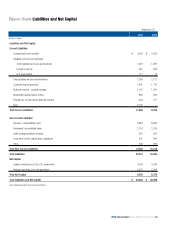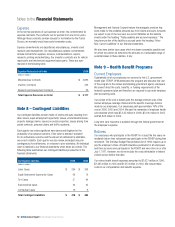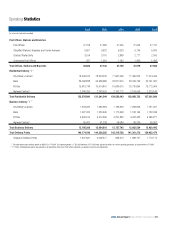US Postal Service 2006 Annual Report Download - page 56
Download and view the complete annual report
Please find page 56 of the 2006 US Postal Service annual report below. You can navigate through the pages in the report by either clicking on the pages listed below, or by using the keyword search tool below to find specific information within the annual report.
54 | 2006 Annual Report United States Postal Service
P.L.108-18
On April 23, 2003, the President signed into law P.L.108-18, the Postal
Civil Service Retirement System Funding Reform Act of 2003, which
changed the way we contribute to the CSRS retirement plan. Although
the law changed the funding of the plan, we determined that we would
still use multi-employer pension plan accounting treatment rules as an
“independent establishment of the executive branch of the United States
government.”
We are required by P.L.108-18 to pay an additional annual amount if
necessary, as determined by OPM, each September, beginning in 2004.
The “supplemental liability” represents the excess of the actuarial present
value of the future benefits liability over the actuarial present value of plan
assets, future contributions, earnings, and other actuarial factors related
to postal participants in the CSRS plan.
In September 2006, OPM estimated the present value of benefits at
$196.9 billion, contributions at $12.3 billion, and plan assets at $180.9
billion as of September 30, 2005. The calculated September 2005
“supplemental liability” of $3.7 billion, was a decrease of $500 million
from the $4.2 billion “supplemental liability” as of September 30, 2004.
This calculation assumed general salary increases of 2.8%, COLAs
of 3.25%, and interest of 6.25% and is intended to provide for the
liquidation of the “supplemental liability” over a 38-year period ending in
September 30, 2043. The following table presents OPM’s estimate of the
present value of our CSRS “Supplemental Liability.”
Present Value Analysis of CSRS
“Supplemental Liability” 2005 2004
(Dollars in billions as of September 30)
Present Value of Benefits $ 196.9 $ 195.0
Present Value of Contributions * $ 12.3 $ 14.1
Current Fund Balance $ 180.9 $ 176.7
Deficit $ (3.7) $ (4.2)
* Expected employer and employee contributions
Our “supplemental liability” payment in 2006 was $257 million, a
decrease of $33 million over the $290 million payment in 2005. Our first
“supplemental liability” payment in 2004 was $240 million.
P.L.108-18 also required that we place in escrow, by September 30,
2006, any “savings” until Congress decides the final disposition of
“savings” from the change in the retirement funding provisions. OPM
calculated the savings at $2,958 million.
Note 11 – Workers’ Compensation
We pay for workers’ compensation costs under a program administered
by DOL. These costs include employees’ medical expenses, payments for
continuation of wages and DOL administrative fees. We record these costs
as an operating expense.
Our liability at September 30, 2006, represents the estimated present
value of the total amount we expect to pay in the future for postal workers
injured through the end of 2006. The estimated total cost of a claim is
based upon the severity of the injury, the age of the injured employee, the
assumed life expectancy of the employee, the trend of our experience with
such an injury, and other factors.
In our calculation of present value for 2006 and 2005, a net discount rate
of -0.8% for medical expenses and 3.3% for compensation claims was
used. At the end of 2006, we estimate our total liability for future workers’
compensation costs at $7,863 million. At the end of 2005 this liability was
$7,521 million. The payout period for this liability will, for some claimants
currently on the rolls, be for the rest of their lives. The liability is sensitive
to changes in inflation and discount rates. An increase of 1% in the
assumptions would decrease our estimate of the liability by approximately
$676 million. A decrease of 1% would increase our estimate of the liability
by approximately $824 million.
In 2004, the net discount rates used to determine the present value
of estimated future workers’ compensation payments was changed, in
consultation with an independent actuary. Our net discount rate is the
estimated difference between what we expect to earn on investments
compared to what we assume the inflation rate will be for medical costs
and wage increases. Our net discount rate of -0.8% for medical claims
means that our assumptions show that the average rate of inflation for
medical claims of 5.5% will exceed our investment returns of 4.7% by
0.8% per year over the expected life of the medical claims. Conversely
we believe that our assumed investment returns of 5.5% will exceed the
rate of inflation on the consumer wages index of 2.2% by 3.3% over the
expected life of the compensation claims. Due to the differing average
lengths claimants stay on the rolls between medical and compensation
claims, we use two different market baskets of bonds funds to calculate
our expected returns.
In 2004, we reduced the medical claims net discount rate from 1.4% to
-0.8% resulting in an increase in our medical claims liability and expense
of $362 million. We increased the compensation claims net discount rate
from 3.0% to 3.3%, thereby reducing that liability and expense by $148
million. These combined changes increased our total workers’ compensa-
tion liability and expense by $214 million. The effect of the adoption of
these changes is accounted for as a change in accounting estimate as
defined by GAAP.
In 2006, we recorded $1,279 million in workers’ compensation expense,
compared to the $838 million in 2005 and $1,239 million recorded in
2004.
Notes to the Financial Statements
(3.7) (4.2)
























